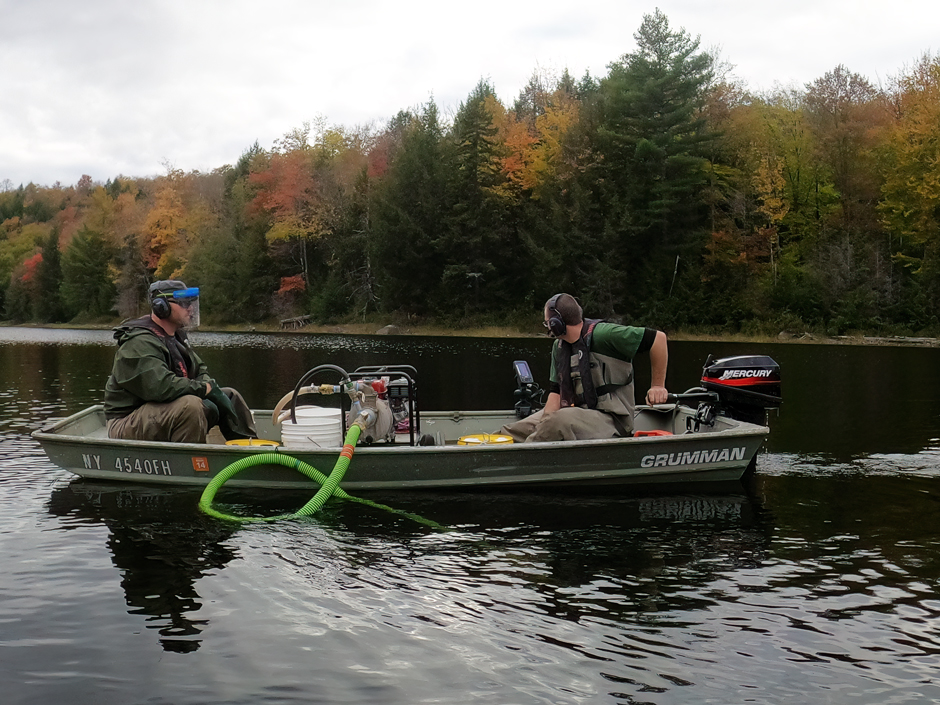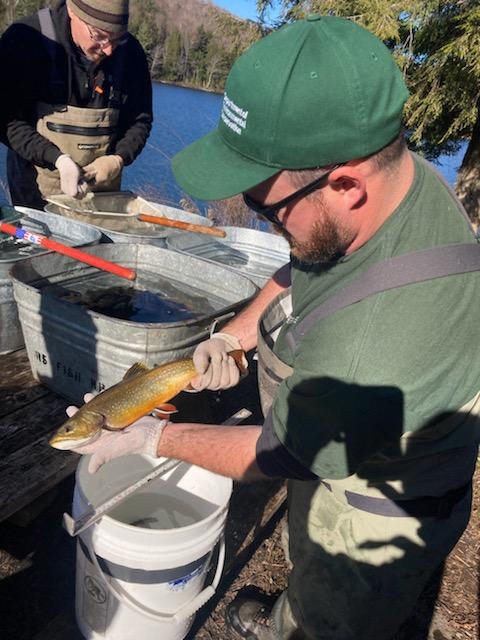Reintroducing Historically Native Fish in America’s Largest Wilderness
 Fish and Wildlife Technician Dustin Dominesey in bow and Fish and Wildlife Technician Adam Kosnick in back of boat conducting a reclamation on Murphy Lake in 2021. (Credit: NYSDEC)
Fish and Wildlife Technician Dustin Dominesey in bow and Fish and Wildlife Technician Adam Kosnick in back of boat conducting a reclamation on Murphy Lake in 2021. (Credit: NYSDEC)Among the dozens of publicly protected national parks, hundreds of wilderness areas, and thousands of state parks in the contiguous U.S., none are larger than the Adirondack Park, a 6 million-acre wilderness area that spreads across upstate New York.
With 3,000 lakes and ponds and 30,000 miles of rivers and streams, the waterways of the Adirondacks are enormous. Diverse aquatic habitats and ecosystems abound, along with bountiful recreational opportunities.
Nearly half of this land is owned by the state of New York and managed through the New York State Department of Environmental Conservation (DEC) as a forest preserve to return the wilderness to its “presettlement” state.
When early European settlers came to the region in the early 1600s, they introduced multiple non-native fish species, beginning a problem that has plagued waterways across the U.S. for centuries.
Rob Fiorentino, a DEC Regional Fisheries Manager in the eastern Adirondacks region, is one of the many scientists and conservationists working to combat this problem. Fiorentino explained that as settlers began pushing further into the wilderness, they brought fish as a food source, introducing them to ponds, lakes, and rivers along the way.

DEC Regional Fisheries Manager Rob Fiorentino and DEC Fisheries Biologist James Pinheiro on Lake Placid conducting a lake trout survey. (Credit: NYSDEC)
Historically Native and Genetically Distinct Adirondack Fish Species
Despite the size of Adirondack Park, it does not boast a diversity of historically native species. According to the New York DEC, after the last ice age, climate and rugged geography restricted fish movement upstream, limiting what species became established.
Since then, brook trout and round whitefish have been the two species that survived, even developing “heritage” strains unique to certain watersheds in the region. Thousands of years without competition from other fish species meant that non-native species complicated a relatively simple ecosystem when they were introduced.
While species such as invasive bass, perch, and crappie are known to harm native populations, Fiorentino does not believe one single species can be blamed, but rather, that sudden competition in the ecosystem led to population declines.
“It’s not that it’s any one specific or particular fish species,” Fiorentino says. “It’s just the change in the fish community often makes it not as good as it was before.”
As a result of the changing ecosystem, round whitefish are now listed as an endangered species, and many brook trout populations have dramatically declined, with some of the heritage strains having gone extinct. Therefore, re-establishing these populations is extremely important to Fiorentino and others in the DEC’s Division of Fish and Wildlife.
Unfortunately, it is difficult to define what is native, given that there are so few fish species but many distinct genetic strains in the Adirondack region. To combat this, Fiorentino explains that he and his team look at the historical pre-settlement presence and community of fish in a certain body of water before deciding on a management plan.
“They’re native to New York state. They’re native to waters within the state, to watersheds within the Adirondacks,” Fiorentino says. “But they might not necessarily be exactly native to that specific single water[body] that you’re talking about.”

DEC Fisheries Biologist Nicole Balk and Fish and Wildlife Technician Megan Beckwith stocking Atlantic salmon into a net pen in Lake Champlain in 2023. (Credit: NYSDEC)
Unique Fish, Unique Management
When managing Adirondack waterways, the DEC adheres to the idea of returning them to their presettlement state, which often involves completely removing non-native species. This method is known as pond reclamation.
Fiorentino explains that since the 1950s, the DEC has used pond reclamation to bring back brook trout ponds. According to their website, reclamation begins by adding rotenone to a pond or lake, a natural toxin that degrades to carbon dioxide and water. After this step, a local heritage strain of brook trout is stocked, and the ecosystem is allowed to recover.
Rotenone is ideal as it has minimal impact on brook trout and round whitefish, and does not harm wildlife that use the pond as a food or drinking source. However, there are limits to which ponds can be reclaimed with this method.
Pond size, the abundance or presence of certain wetlands, and the likelihood of non-native fish returning to the pond via outlets may inhibit pond reclamation. Nonetheless, over 100 ponds have been reclaimed in the eastern Adirondacks.
Balancing Recreation and Conservation in Adirondack Park
The Adirondacks are a popular fishing region, and regulations have been placed to limit the spread of non-native species. For both reclaimed and non-reclaimed bodies of water, the DEC has taken steps to inform anglers of the problems in Adirondack waterways and how to avoid worsening them.
“At our boat launch sites, we have kiosks that have information in them, telling how you should treat your bait fish, what you should do with them, the proper way to dispose of them,” Fiorentino explains.
Along with bait fish, non-native species can spread by water vessels. With many waterways in the region, Fiorentino explains that it is common for people to bring their boats to multiple locations and unintentionally bring unwanted guests along with them.
Similar to regulations on bait fish, the DEC has used kiosks, posters, and informational campaigns to educate anglers about how non-native species spread. The DEC requires self-certification from boat owners to certify that they have cleaned and dried their boats when moving them between different waterways.
“When that first came out, that really wasn’t well understood,” Fiorentino says. “And I’m sure some people didn’t appreciate it because now they have to take more time away from their recreational activity and make sure [the boat is] both clean and dry.”

DEC Fisheries Biologist Chris Powers and Fish and Wildlife Technician Adam Kosnick in the background, collecting brook trout eggs from Fishbrook Pond in 2022. (Credit: NYSDEC)
Conclusion
As the DEC continues to learn how invasive species spread, it continues to carry out management efforts and educate the public. Despite some initial confusion on the purpose of regulations, cases of invasive species causing damage to their local waterways have made the public more receptive. Invasive plants, insects, and other aquatic species have also damaged local water bodies and tourism.
For example, invasive zebra mussels have spread to some Adirondack waterways, impacting water filtration for local villages. Fiorentino explains that such instances increase people’s appreciation for the steps being taken to reduce all non-native species.
“Taking that moment to do the right thing by just making sure your equipment is clean doesn’t take a lot away from your personal recreation, but there’s a potential there that you could really impact a lot of other people’s,” Fiorentino says.
It is an uphill battle with delicate ecosystems and fish species. Still, conservation and educational successes give Fiorentino and the DEC hope about preserving the ecologically important and pristine waterways of America’s largest wilderness.




0 comments